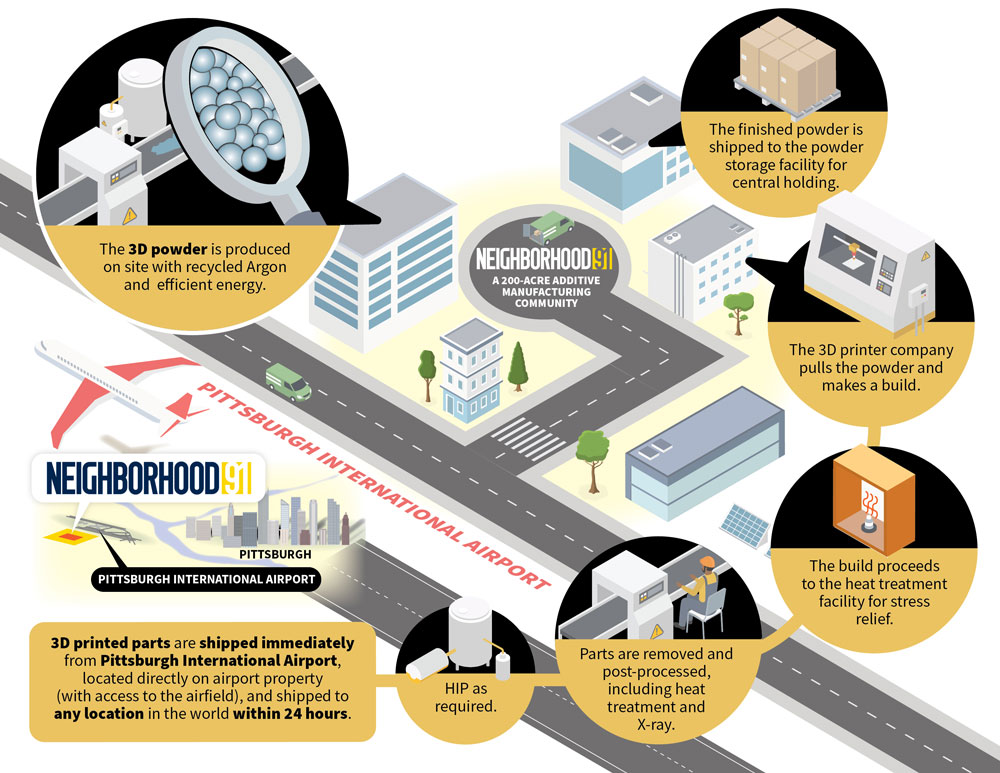Pittsburgh International Airport and the University of Pittsburgh have joined forces to help make their locality a world leader in additive manufacturing. Neighbourhood 91 is a new concept the parties have developed to form part of the Pittsburgh Airport Innovation Campus. Built adjacent to the airport terminal and runway, the facility aims to connect all parts of the additive manufacturing supply chain, with exceptional benefits to lead times and delivery.
“The Pittsburgh region has always been a world leader in manufacturing,” commented Rich Fitzgerald, Allegheny County Executive. “Now that industry has evolved into additive manufacturing and 3D printing, and through Neighborhood 91, we have laid the groundwork to become the global epicenter.
“The neighborhood concept will create enormous efficiencies but just as important is leveraging our region’s universities, which will provide necessary research and development and fuel the workforce to the fill these jobs.”

Building on historic and local expertise
The reputed “Steel City,” Pittsburgh is a historic manufacturing hub for the U.S. In addition to steel, the city has expertise in aluminum, glass, shipbuilding, petroleum, and electronics production. Where 3D printing is concerned, the city is home to lightweight metals engineering and manufacturing specialist Arconic, and the academic expertise of the University of Pittsburgh and Carnegie Mellon University, both of which contribute significantly to the additive manufacturing research. Around 20 miles south east of Pittsburgh is North Huntingdon, the international headquarters of leading binder jet 3D printer provider ExOne. Another 20 miles east and there’s the base of additive manufacturing metal powder producer Kennametal. Such historic and geographic links with industry are what Pittsburgh International Airport is seeking to leverage in the creation of Neighbourhood 91. “Part of our vision as an airport is to advance the region’s role as a world leader,” commented Christina Cassotis, Pittsburgh International Airport CEO. “Additive Manufacturing is looking for a place to call home and no one has made that happen – until now.
“The Pittsburgh region is a natural fit based on its history and its assets of today and our airport is leading the way to get it done along with our university partners.”
Shared capital resources for 3D printing
The campus of Neighbourhood 91 will be built surrounding shared capital resources for facility partners, including an onsite communal supply of powder. Other offerings to be part of the ecosystem are listed as:
– Powder, parts, post-production, testing and analysis
– Efficiencies in production/post-production and delivery
– Tenants’ clients cost savings from on-demand printing
– Reduced transportation costs
– Airport access
– Argon, helium and other noble gas supply
The University of Pittsburgh has helped the local airport develop the Neighbourhood 91 concept. According to Patrick Gallagher, University of Pittsburgh Chancellor, “Neighborhood 91 brings together the kind of collaborative environment needed to lead in today’s competitive advanced manufacturing economy. It combines the region’s strength in additive manufacturing and advanced materials industries with the intellectual capital of its world-class research universities.”

So far, argon gas supplier and gas recycling specialist Arencibia has been confirmed as an industrial partner for the site. Industrial additive manufacturing consultancy firm The Barnes Group Advisors has also aided Pittsburgh International Airport in the creation of an AM cluster strategy.
Construction of Neighbourhood 91 is expected to begin in 2020. When operational, partners estimate the cluster could reduce lead times and transportation cost for 3D printed parts by up to 80%.
For more of the latest news please subscribe to the 3D Printing Industry newsletter, follow us on Twitter and like us on Facebook. Seeking jobs in engineering? Make your profile on 3D Printing Jobs, or advertise to find experts in your area.
Featured image shows a map showing the location of Neighbourhood 91. Image via Pittsburgh International Airport



